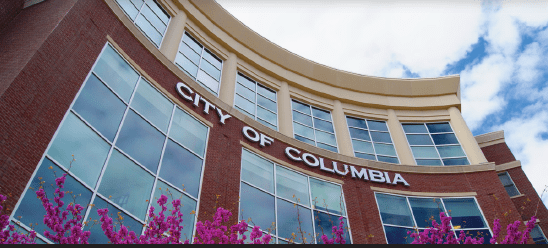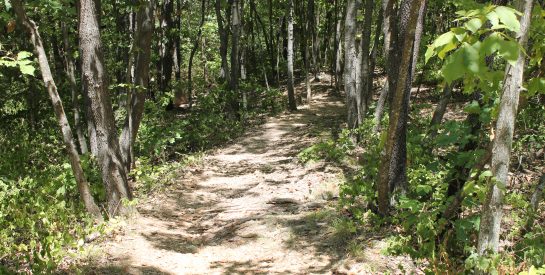
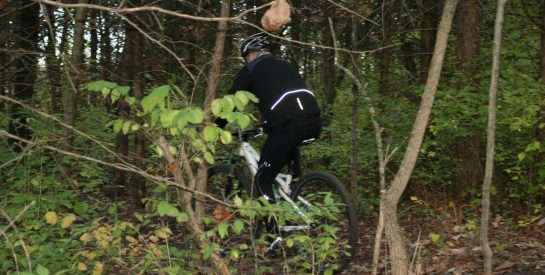
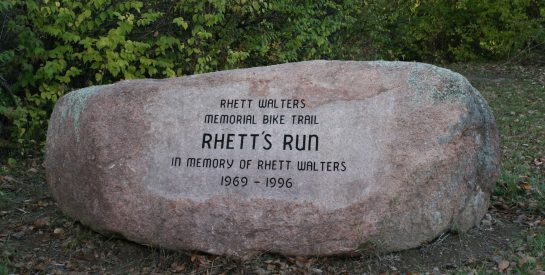
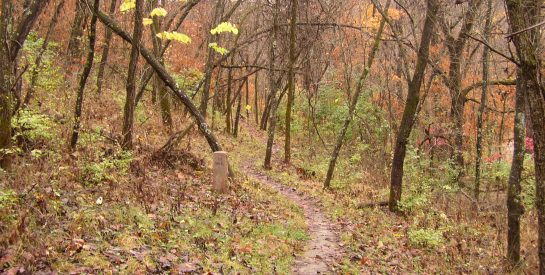
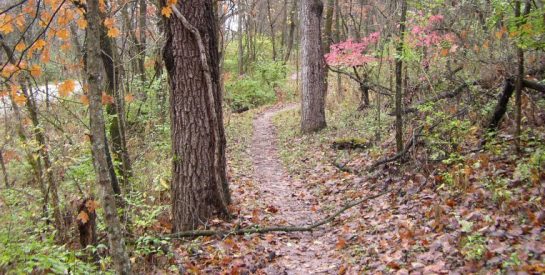
About Rhett Walters Memorial Mountain Bike Trail (a.k.a. Rhett’s Run)
This challenging mountain bike course was designed by the 1996 Olympics key course designers. The trailhead is east of Antimi Baseball/Softball Complex in Cosmo Park. A large boulder marks the trailhead. The site for the trail is approximately 75 acres. The trail is 4.1 miles in length with the majority of it being constructed to a three-foot width. Hikers will also enjoy this scenic trail. The trail is a memorial to Rhett Humfield Walters who was killed in a tragic motorcycle accident in April of 1996.
If you would like to host an event on the trail, please fill out a Park Special Use Application.
- Trail Miles: 4.1 miles, dirt
- Map of Cosmo Parkopens PDF file
- Map of Rhett’s Runopens PDF file
Other area mountain bike trails
There are two other mountain bike trails in the Columbia area that are not managed by Columbia Parks and Recreation, but may be of interest to mountain bike enthusiasts. Below are links to the managing agencies’ websites:
Trail history
The “Rhett’s Run” Trail idea originated in May of 1996. The trail was proposed as a memorial to Rhett Humfield Walters who was killed in a motorcycle accident in April 1996. In February 1997, the Rhett Walters Memorial Trail Committee began working with the Parks and Recreation Department to develop a proposal for a public mountain bike trail. The committee’s goal was to design a challenging mountain bike course and to build it in a location that would allow the greatest amount of use for all ages and abilities, as well as minimize the impact to the area and the environment. With this goal in mind, the Committee approached the City of Columbia, seeking the City’s support for and involvement with the project.
The following is a brief time line of the events occurring since February 1997 and September 1998 during the planning process for the trail.
- February 1997: Memorial Committee appears before Parks and Recreation Commission to present preliminary proposal. Commission moves to approve the concept of developing a mountain bike park, but to pursue it with no obligation of the City at the present time. More information was to be provided as development plans were established.
- March 1997: Committee appears before the City Council under scheduled public comments. Council directs staff to work with the committee and study the potential for a mountain bike facility.
- April/May 1997: Committee and staff evaluate three potential sites for the trail. Committee recommends that trail be located in the Columbia Cosmopolitan Recreation Area.
- June 1997: Committee hosts a Design Workshop that is open to the public. Approximately 40 people attend. Environmental organizations begin to express concern about the size and scope of the project and its impact on Cosmo Park.
- October 1997: Committee submits formal report on the proposed mountain bike project to the Parks and Recreation Commission.
- November 1997: Commission reviews report and votes to hold a formal public hearing on the project. Bicycle Commission endorses project provided it is privately funded.
- February 1998: Commission holds public hearing. Numerous citizens attend with at least twenty-two individuals testifying. Both supporters and opponents are present.
- March 1998: On a 3-4 vote, the Commission defeats a motion to endorse the proposed mountain bike project as currently envisioned (up to six miles of trail, multipurpose shelter/restroom, parking, and possible expansion of other biking facilities, such as a BMX track). Instructs staff to see if an alternate site can be identified.
- April 1998: Commission is advised that staff has not been able to identify any additional sites which are satisfactory to the Memorial Committee. Representatives of the Committee ask to present a revised plan for the project.
-
May 1998: Committee offers to scale project down to just the construction of trails designed primarily for riding by citizens of Columbia and the immediate area. Development of facilities for competitive events are not to be included in the project. Commission supports the continued planning of the revised proposal under the following conditions:
- A planning committee be established to develop detailed plans for the facility.
- Once planned, the trail be flagged in the field.
- The Commission and all interested members of the public be given the opportunity to walk the proposed layout of the trail.
- Final recommendation to the Council be withheld until the proposed layout is determined to be acceptable.
- July 1998: Trail design is completed. Revised project includes the construction of approximately 2.5 miles of trail.
- August 1998: Design document is presented to Commission and a public tour of the proposed trail is held. Five members of the Commission and several members of the public attend.
- September 1998: On a 3-1 vote, the Commission approves a motion to recommend to the Council the use of the north part of Cosmo Park for development of the mountain bike trail.
Throughout the entire process outlined above, one of the primary concerns was the impact of the proposed project on the natural environment of Cosmo Park. The route was reviewed by the City Arborist, and it was his opinion that the trail construction would not cause damage to the trees in the park. The final design document addressed these environmental concerns, examples include:
- Majority of trail constructed only three feet in width with a trail corridor clearance of six feet.
- Construction was done primarily with hand tools. No old growth or large trees removed.
- Trail was properly designed to minimize erosion, including proper benching, switchbacks, climbing turns, and stream crossings.
- Proper signage was developed for the intersection of the biking trail and existing pedestrian trails.
The trail was designed by Brian Stickel and John Bailey of Mountain Designs, key course designers for the 1996 Olympic mountain bike courses. (Collectively, they have designed or consulted on national, world cup and world championship courses.) The trail was designed not to intrude upon the wetlands in the far north end of the park and was routed along the hillsides just south of the Bear Creek drainage area.
Actual construction of the trail began in August 1999. A dedication ceremony was held October 30, 1999. The entire project was financed with funds raised by the Rhett Walters Memorial Mountain Bike Trail Committee.

